
Watch NASA's 100-Year NACA Symposium Live Online Today

NASA is celebrating the 100-year anniversary of its predecessor, NACA — the National Advisory Committee for Aeronautics — and you can watch the celebration live online today (March 4).
The NACA celebration kicked off Tuesday, but NASA will host another full day of panels and speakers discussing the history and future of the space agency. Today's panels include a keynote speech by John D. Anderson, of the National Air and Space Museum, a panel about NACA research and another about "the next assignment." Watch those NACA panels and others live on Space.com via NASA TV starting at 9:10 a.m. EST (1410 GMT).
"The NACA was formed because our nation's leaders were concerned the U.S. was losing its edge in aviation technology to Europe, where World War 1 was raging on," NASA administrator Charles Bolden said in a statement. "Its mission, in part, was to 'supervise and direct the scientific study of the problems of flight with a view to their practical solution.' As you all know, we not only regained that edge, but we became the world leaders in civil aviation."
Check out the full schedule of events below. All times in EST.
9:15 – 10:00 | Keynote Address: |
The NACA in the 1930’s – Trailblazing the Technical World of Aerodynamics — John D. Anderson, National Air and Space Museum | |
10:00 – 11:45 | Key Aspects of NACA Research |
Moderator: Michael J. Neufeld, National Air and Space Museum The NACA and Research Policy at the Hands of History — Robert Ferguson, Independent Researcher Epochs of Space Technology at NASA: NACA to OART and Beyond — John C. Mankins, Artemis Innovation Management Solutions, LLC Women of NACA: STEM Stories to Inspire Future Generations — Adrienne Provenzano, STEAM Educator The NACA at Lewis Laboratory, a Legacy of Ohioans Solving the Problem of Flight — Shannon Bohle, Archivopedia, LLC | |
1:00 – 3:00 | Transformations |
Moderator: F. Robert van der Linden, National Air and Space Museum The NACA Transition to Space: Validating the Blunt Body — Glenn Bugos, NASA Ames Research Center Reaction Control Systems and the NACA — Christian Gelzer, NASA Armstrong Research Center Tin Soldiers and Glass Slippers: How Postwar Competition Sailplane Development Shifted from America to Europe — Russell Lee, National Air and Space Museum Towards Victory: NACA Public Relations on the Coattails of the Cold War, 1946-1958 — Kristen Starr, Auburn University | |
3:30 – 5:00 | The Next Assignment: A Panel Discussion |
Chair: Peter Jakab, National Air and Space Museum Mark Lewis, IDA Science and Technology Policy Institute Janet Bednarek, University of Dayton Peter Westwick, University of Southern California |
Follow Miriam Kramer @mirikramer. Follow us @Spacedotcom, Facebookand Google+.
Get the Space.com Newsletter
Breaking space news, the latest updates on rocket launches, skywatching events and more!
Join our Space Forums to keep talking space on the latest missions, night sky and more! And if you have a news tip, correction or comment, let us know at: community@space.com.

Miriam Kramer joined Space.com as a Staff Writer in December 2012. Since then, she has floated in weightlessness on a zero-gravity flight, felt the pull of 4-Gs in a trainer aircraft and watched rockets soar into space from Florida and Virginia. She also served as Space.com's lead space entertainment reporter, and enjoys all aspects of space news, astronomy and commercial spaceflight. Miriam has also presented space stories during live interviews with Fox News and other TV and radio outlets. She originally hails from Knoxville, Tennessee where she and her family would take trips to dark spots on the outskirts of town to watch meteor showers every year. She loves to travel and one day hopes to see the northern lights in person. Miriam is currently a space reporter with Axios, writing the Axios Space newsletter. You can follow Miriam on Twitter.









